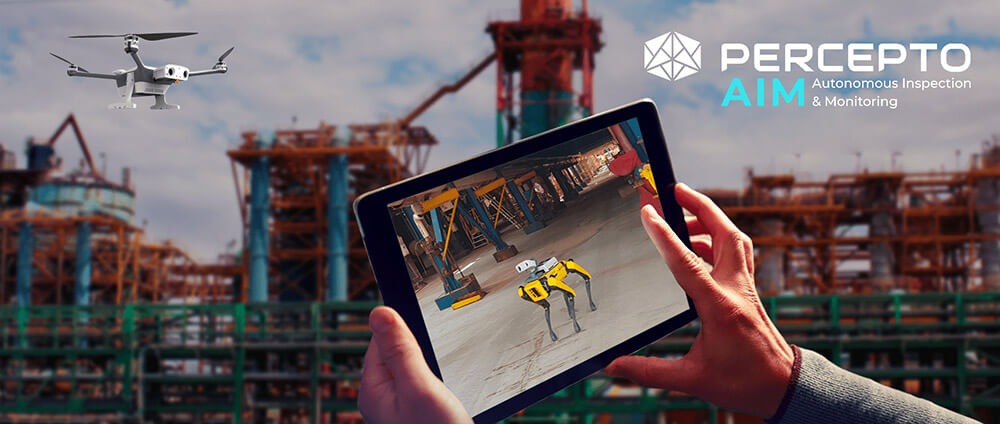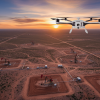It might be a bit early for a year-end summary, but given the exciting news yesterday, it feels like a good opportunity to reflect on the amazing journey we’ve had thus far, and where we’re going next.
2020 has truly been a year of triumph for all of us at Percepto and for me personally as CEO. With the launch of our revolutionary AIM platform and the continuing global uptake of our autonomous industrial Drone-in-a-Box (DIB) systems – we reached some truly remarkable milestones in 2020. And the fact that we received a massive strategic investment from one of the world’s largest and most prestigious industrial concerns, Koch Disruptive Industries, who share our commitment to building Percepto into a new category leader, has actually made the disastrous 2020 one of the best years Percepto ever had.
Taking the “Apple” approach
This year was the year that our vision of end-to-end autonomy in industrial robotics really came to fruition.
From Percepto’s earliest days, we chose to regard robotic autonomy differently – starting, of course, with our own autonomous drones. Autonomous drones, we realized, don’t just need to fly on their own. Industrial sites really need them to do everything on their own – fly, dock, charge, self-maintain, upload data, analyze data, report in real time…and so much more.
Technologically, we essentially took the “Apple” approach. Unlike most companies, which offered solutions to one problem at a time, we bundled data collection in industrial sites with data storage, manipulation, analysis and (most importantly) the delivery of data-driven insights. We made it so easy to go autonomous, that companies couldn’t resist making the transition to end-to-end inspection and monitoring solutions powered by drones.
Commercially, we translated this into a completely different product approach – a new and different direction in drone-powered commercial applications. While most companies were offering software for commercial applications of piloted drones (mostly for DJI drones), we were laser-focused on applications of our fully autonomous Drone-in-a-Box (DIB) solution.
So, we created this space…and we are now firmly established as the market leaders in it. Over the past six years, Percepto has grown to be by far the most deployed DIB on the market, and the market standard against which competing platforms are measured.
AIMing higher
I have no doubt that we’re going to retain our leadership in the DIB space. Yet, taking a holistic view of industrial sites – we realized that there’s an even greater autonomous peak to be conquered.
Working with industry leaders such as Florida Power & Light, Verizon, ICL Dead Sea and dozens of others over the past years taught us how truly disruptive end-to-end automation is for inspection and monitoring of industrial assets. Yet even as we dominated the airspace above industrial sites, and brought previously unheard of drone-driven data collection and AI-powered insights to industrial stakeholders – we realized that there was something missing in the autonomous industrial robotics picture.
This something was AIM. For Percepto, it’s an evolution. But for the market, it’s a revolution.

AIM is disruptive – completely changing the industrial inspection and monitoring market. We understood that there are some aspects of remote inspection and monitoring that can’t be fulfilled by air alone. Our customers needed additional robotics, while still maintaining a fully autonomous cycle. They needed one system that holds all visual data from various sources. And they needed the ability to easily control both the data collection and the data visualization and analysis phases remotely.
Digitizing decades-old best practices
Heavy industrial companies have always relied on inspection and monitoring to guarantee business continuity, minimize risk and eliminate unnecessary downtime. But traditional methods relied mainly on manual and resource-intensive best practices. Billions of dollars were, and in most cases still are, spent on inspection regimes that are, to say the least, low-frequency. How low? In some cases, if methods on-site have been digitized, critical infrastructure can be inspected weekly – but usually, it’s monthly and even yearly. And sometimes, literally never. And it’s not just quantity – it’s quality. Traditional inspection and monitoring lack consistency, objectivity, and the ability to identify data-driven trends over time.
By way of example, despite the company’s alignment with industry best practices, faulty equipment owned by California’s largest utility, PG&E, sparked the deadly 2018 fires in California that ultimately led to the company’s bankruptcy. Similar issues can be found in many other heavy industrial facilities and infrastructures. Companies are spending billions on sub-optimal inspection regimes, which ultimately lead to higher losses due to unnecessary downtime and lower efficiency. A mine, a chemical plant, a refinery, or any other major facility may produce over a billion dollars a year, yet suffer losses of tens of millions on efficiency and downtime issues, not even taking into account major malfunction events.
Given these numbers, we knew we could aim higher, so to speak. With AIM, not only can we inspect entire sites from the air, ground, and sea – we can do so daily, or even hourly. And it is this high-frequency inspection that makes all the difference. Because industrial site stakeholders need to be smarter and rely on information from more than just one data collection mission. Correlating data from multiple missions leads to decision-making based on up-to-date visual data trends and highly robust digital twins. True to our principles, AIM enables our customers to focus less on the collection of data via any of our autonomous robotic solutions, and more on the insights derived from the data collection. What’s more, AIM empowers more people – democratizing access to data-driven insights.
What’s next for Percepto?
We pioneered and ultimately dominate the Drone-in-a-Box space – which has created a demonstrable path to ROI and very high traction for Percepto in heavy industries. Together with tier-1 partners like Boston Dynamics, I expect Percepto to see rapid and widespread growth in autonomous industrial inspection and monitoring.
Moving into the third decade of the 21st century, Percepto will continue to focus on evolving customer needs, leading this new category we created. It’s a lot of responsibility, but we’re used to aiming high and meeting the ambitious goals we set for ourselves.





